|
Rice Ecosystem
Systems of rice cultivation in various rice growing areas are largely depends upon the crop growing conditions like soil type, available water and prevailing monsoon.
The principal rice ecosystems followed in Tamil Nadu, Kerala and Karnataka are:
1.Wet system
2.Dry system
3.Semidry system
| |
Wet System |
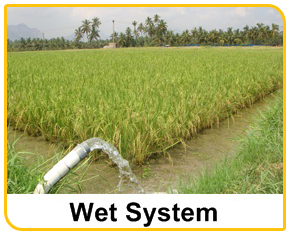 |
The wet system is also known as Irrigated rice. In this system, the crop is grown under wet (irrigated) conditions from seed to seed. The field is brought to a soft puddle by repeated ploughings with 5-7 cm standing water. After obtaining a soft puddle and perfect levelling, rice seedlings are transplanted or sprouted seeds dibbled or broadcasted on the puddle field. This system of cultivation is followed wherever assured irrigation water is available. This irrigated rice contributes to 55 per cent of the total rice production
|
METHODS FOLLOWED IN WET SYSTEM ARE
- SYSTEM OF RICE INTENSIFICATION
- TRANSPLANTED PUDDLED LOWLAND RICE
- DIRECT WET SEEDED PUDDLED LOWLAND RICE
| Top |
| System of Rice Intensification |
System of Rice Intensification (SRI) is a methodology for increasing the productivity of irrigated rice by changing the management of plants, soil, water and nutrients particularly by eliciting greater root growth. SRI is not a technology because something still evolving and improving, season by season, as more experience is gained and as more farmers, scientists and others apply their intelligence and insights to making rice production more efficient and sustainable. |
|
| Critical steps in SRI |
- Nursery area and Seed rate
- Seedling age
- Square planting
- Water management
- Mechanical (Cono) weeder usage
|
| Nursery area and seed rate |
|
- Only 7-8 kg of seed is required to plant 1 ha.
- Nursery area is reduced to 100m2 / ha.
- For raised beds @ 1 x 5 m and 20 beds are required for 1 ha.
- Spread polythene sheets over the beds evenly.
- Fill the soil evenly over the Polythene sheets upto 4cm.
- Uniformly spread 375 g of seeds in each 5 sq.m. nursery bed.
- Watering through rose can is advisable.
- Cover the seed bed using locally available mulching materials like coirpith/straw
|
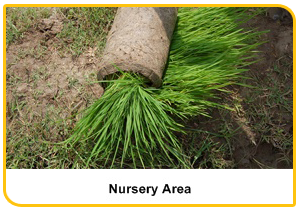 |
| |
Seedling age |
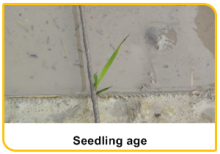 |
- Fourteen days old seedlings were recommended for transplanting (3 leaves stage)
- If the nursery bed is properly prepared with sufficient organic manure, the seedling growth will be good to handle.
|
| Water Management |
|
- Water management is one of the critical steps in SRI and provision of aerobic environment in rice fields is the core point in SRI.
- Plants with truncated roots cannot access the residual soil moisture in lower horizons that is accessible to plants which have large and functioning roots systems to maintain their growth and productivity.
- Hence, alternate wetting and drying is advocated.
- Irrigation only to moist the soil in the early period of 10 days.
- Restoring irrigation to a maximum depth of 2.5cm after development of hairline cracks in the soil until panicle initiation.
- Increasing irrigation depth to 5.0 cm after Panicle initiation one day after disappearance of ponded water.
|
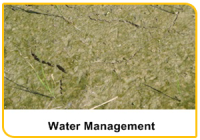 |
| |
Mechanical (Cono) weeder usage |
 |
- Square planting eases the cono/rotary weeder operation in two directions, and thereby weed management could be effected efficiently. In SRI, weeder should be used at 10 days interval from the date of transplanting. Three labours are enough to weed one acre.
- Weeds are trampled and on decay the nutrient are ploughed back to the soil.
- Soil is frequently disturbed which has beneficial physico chemical – biological results in soil.
- Root pruning triggers the tillering that results in bursting out of tillers.
- Water level should be properly monitored for usage of weeder.
- It is important to remove the left out weeds by hand. By this the cost of weeding is reduced by 52.5%.
|
| |
Top |
| SRI Practices |
|
The Principles of SRI are achieved by following certain practices
|
| Season |
|
- Dry season with assured irrigation is more suitable.
- Difficulty in crop establishment may be seen in areas with heavy downpour (NE Monsoon periods of Tamil Nadu)
|
| Varieties |
|
Hybrids and varieties with heavy tillering. |
| Seed rate |
|
7- 8 kg / ha for single seedling per hill |
| Nursery Management |
|
- Required nursery area is 100 m2/ha (or) 2.5 cent/ha – 1cent/acre
- Usage of well decomposed good quality FYM judiciously.
- For raised beds @ 1 x 5 m and 20 beds are required for 1 ha.
- Powdered DAP may be applied @ 95g/raised bed in total 1.9 kg should be used.
- Spread polythene sheets over the beds evenly. Old polysacks can also be used.
- ill the soil evenly on the Polythene sheets upto 4cm.
- Seed treatment can be done with Pseudomonas 10g/kg seed.
- 75 g Azophos biofertiliser/kg seed.
- Uniformly spread 375 g of seeds in each 5 sq.m. nursery bed.
- Watering through rose can is advisable.
- Cover the seed bed using locally available mulching materials like coirpith/straw.
|
| Main field preparation |
|
- Plough the land during summer to economize the water requirement for initial preparation of land.
- Flood the field 1 or 2 days before ploughing and allow water to soak in. Keep the surface of the field covered with water.
- Keep water to a depth of 2.5cm at the time of puddling.
- Good leveling (laser leveling) of the main field is essential in SRI. Field drainage is an important component in SRI.
|
| Transplanting |
|
- The seedling along with the soil intact with the roots should be removed and plant them immediately.
- Fourteen days old seedlings were recommended for transplanting. At this stage the seedling will have 3 leaves.
- If the nursery bed is properly prepared with sufficient organic manure, the seedling growth will be good to handle.
|
| Plant spacing |
|
- Square planting at 25 x 25cm ensures optimum space for efficient utilization of resources.
- Place single seedling at intersecting points marked with the marker.
- Place the seedling without plunging too deep into the soil.
|
| Nutirent Management |
|
- Apply 12.5 t of FYM or compost or green leaf manure @ 6.25 t/ha.
- Organic manures addition is recommended in SRI cultivation, as they are found to supply essential nutrients, and creates
favorable conditions for soil microbes being a source of carbon.
- Apply fertilizer nutrients as per soil test recommendations.
- N dose may be through Leaf Color Chart (LCC).
- P & K may be through Site Specific Nutrition Management.
- Depending on the necessity, top dress with chemical fertilizers.
|
| Water Management |
|
Water management is one of the critical steps in SRI and provision of aerobic environment in rice fields is the core point in SRI. Irrigate to 2.5 cm depth of water level after hairline crack formation up to panicle initiation and after that disappearance of ponded water. Water saving in this system is 40-50% from planting to harvest. Farmers using ground water will realize the water, time and electricity saving.
- Regular water application to keep soil moist but not saturated.
- Intermittent wetting and drying for adequate aeration during vegetative phase.
- Relatively frequent watering after vegetative phase.
- No water stagnation at any stage.
|
| Weeder Use |
|
- Using weeder is of primary importance in SRI.
- Use simple rotary weeder between crop rows in both the directions starting from 10 days after planting
- About four rotary weedings at 10 to 15 days interval could be adequate till panicle initiation
- If necessary, one or two hand weedings may be necessary to remove weeds closer to rice plants.
|
| Top |
| Advantages of SRI |
|
- Saving in Seed requirement- Since single seedling is planted at wider spacing. Seed requirement in SRI is only 7-8 kg per hectare. This is particularly useful in the case of hybrids where seed cost is very high.
- Reduction in nursery area.
- Reduction in nursery duration.
- Increased tillering- 30 tillers per plant are fairly easy to achieve.
- Profused root growth- Greater force required to uproot SRI plants than conventional plants.
- Improved grain filling- Improvements in grain filling with larger panicles and higher panicle weight have been observed.
- Water Savings- Since the soil is kept moist only during vegetative growth phase and only minimal water is using during reproductive phase, SRI results in water savings to an extent of 35 to 40 % compared to conventional method.
- Less Lodging- SRI provides good growth environment for rice plants that putforth stronger tillers and extensive root growth and are more resistant to lodging.
- Less incidence of pests and diseases - As SRI plants are stronger, the incidence of pests and diseases is low.
- Reduced chemicals fertilizer- Though chemicals fertilizer increase the yield in SRI however resource poor farmers still can apply the locally available organic manures that still maintain higher yields while reducing the cost of externally purchased inputs.
- Increase grain Yield- Higher grain yields are associated with SRI than conventional method. Increased net returns up to 83 to 206% depending on wage rate.
- Reduced rodent damage in the fieid.
- Higher net profit.
|

 |
| Top |
| |
 Constraints in the adoption of SRI Constraints in the adoption of SRI |
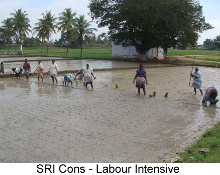 |
- Require strict water control practices
- Initially SRI method require more labourers
- Requires greater skill for transplanting
- Weed menace is relatively higher than conventional transplanting.
- As SRI is labour intensive it is not suitable for large scale production.
- Traditional mindset of the farmers
- Lack of awareness about the technology
- Non availability of critical implements like marker and weeders
- Lack of co-operation from the transplanting labourers
|
| |
Top |
| Crop response |
|
- Higher plant height
- Higher root growth.
- Higher tillering of even shy tillering genotypes
- Increase in number of productive panicles/m2
- Higher number of grains /panicle
- Higher % of filled grains per panicle
- Lodging resistance
- Leaves remain green up to harvest
- Resistance to adverse effects of drought
- Higher nutrient use efficiency
- Higher biochemical activities
- Higher grain and straw yield.
- Higher out turn of milled rice.
|
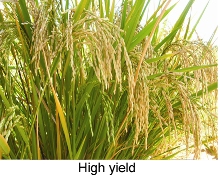 |
| Top |
Differences between conventional and SRI method of cultivation
| Practices |
Component |
Conventional |
SRI |
Nursery (to plant/ ha) |
Area
Seed rate
(kg /ha) |
800 m2
Recommended: 60 kg/ha |
100 m2
7-8 kg/ha |
Farmers’ practice: 125 – 150 kg/ha |
| Planting |
Seedling age |
21+ |
14 |
| Number of seedlings/ hill |
2-3 + |
1 |
| Method |
Recommended:Rectangular |
Square |
Farmers’ practice:Random |
| Spacing |
Recommended: 15 x 10 cm
(105 – 115 days crop)
20 x 10 cm (135-155 days crop) |
25 x 25 cm |
Farmers’ practice : Variable |
| No. of hills/ metre square |
66 / 50 / ± |
16 |
| Irrigation |
Recommended |
Irrigate to 5 cm depth one day after the disappearance of ponded water |
Irrigate to 2.5 cm depth (after hairline crack formation up to panicle initiation and after disappearance of Ponded water). |
| Farmers’ practice |
Flooding (Variable depths) |
| Weeding |
Recommended |
Pre-emergence herbicide + hand weeding at 30 DAT (or) hand weeding at 15,30 DAT |
Using rotary / cono weeder in between rows in both directions at 10, 20, 30 and 40 DAT and hand removal of left out weeds. |
Cost of Comparision
Cost of Cultivation
| Sl.No |
Details |
Total Expenditure (Rs. / Ha) |
| Conventional |
SRI |
| 1. |
Nursery |
2100 |
681 |
| 2. |
Main field preparations |
2005 |
2005 |
| 3. |
Manures and Fertilizers |
7254 |
7254 |
| 4. |
Transplanting |
2400 |
3200 |
| 5. |
Weeding |
3200 |
3200 |
| 6. |
Irrigation |
300 |
240 |
| 7. |
Plant Protection |
660 |
660 |
| 8. |
Harvest |
3500 |
3500 |
| |
Total |
21419 |
19060 |
Economic Benefits
| Sl.No |
Details |
Conventional |
SRI |
| 1. |
Revenue from grain yield @Rs. 7/Kg |
42441 |
56014 |
| 2. |
Revenue from straw yield @Rs. 0.25/Kg |
2263 |
2918 |
| 3. |
Total revenue (in Rs./Ha) |
44704 |
58932 |
| 4. |
Total Expenditure (In Rs./Ha) |
21429 |
19060 |
| 5. |
Net Profit (in Rs./Ha) |
11149 |
23868 |
| 6. |
C B Ratio |
2.08 |
3.09 |
| |
Top |
| Transplanted Puddled Lowland Rice |
|
 Nursery Management Nursery Management |
| Wet Nursery |
|
Nursery area
Select 20 cents (800 m2) of land area near to water source for raising seedlings for one hectare.
Seed rate
30 kg for long duration
40 kg for medium duration
60 kg for short duration varieties and
20 kg for hybrids
Forming Seedbeds and sowing
- Mark plots of 2.5m breadth with channels 30 cm wide all around the seedbeds.
- Length of the seed bed may vary from 8 to 10m according to soil and slope of the land.
- Collect the puddled soil from the channel and spread on the seedbeds or drag a heavy along the channel to lower it, so that the seed bed is at a higher level.
- Level the surface of the seedbed, so that the water drains into the channel. Sow the sprouted seeds uniformly on the seedbed, having thin film of water in the nursery.
|
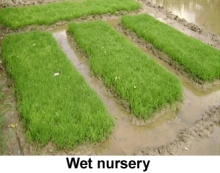 |
| |
Dry Nursery |
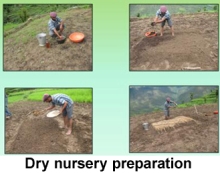
|
Nursery area
Select 20 cents (800 m2) of land area for raising seedlings for one hectare.
Seed rate
30 kg for long duration
40 kg for medium duration
60 kg for short duration varieties and
20 kg for hybrids
Forming Seedbeds and sowing
- Dry ploughed field with fine tilth is required.
- Nursery area with sand and loamy soil status is more suitable for this type of nursery.
- Plots of 1 to 1.5 m width of beds and channels may be formed. Length may be according to the slope and soil. Raised beds are more ideal if the soil is clayey in nature.
- Sowing may be dry seeding. Seeds may be covered with sand and finely powdered well decomposed farm yard manure.
- Irrigation may be done to wet the soil to saturation.
- Optimum age for transplanting – 4th leaf stage
- This type of nursery is handy in times of delayed receipt of canal water.
|
| Main Field Preparation |
|
Land preparation - Tillage
- Plough the land during summer to economize the water requirement for initial preparation of land.
- Flood the field 1 or 2 days before ploughing and allow water to soak in. Keep the surface of the field covered with water.
- Keep water to a depth of 2.5cm at the time of puddling. After puddling perfect land levelling is required
|
 |
| |
Manures and Basal Feritlizer application |

|
Application of organic manures :
- Apply 12.5 t of FYM or compost or green leaf manure @ 6.25 t/ha.
- If green manure is raised @ 20 kg /ha in situ, incorporate it to a depth of 15 cm using a green manure trampler or tractor.
- Apply 22 kg urea / ha at the time of first puddling while incorporating the stubbles of previous crop to compensate immobilization of N by the stubbles.
- This may be done atleast 10 days prior to planting of subsequent crop.
Biofertilizer application :
Mix 10 packets (2000 g)/ha of Azospirillum and 10 packets (2000g/ha)of Phosphobacteria or 20 packets (4000g/ha) of Azophos inoculants with 25 kg FYM and 25 kg of soil and broadcast the mixture uniformly in the main field before transplanting and Pseudomonas fluorescens (Pf 1) at 2.5 kg/ha mixed with 50 kg FYM and 25 kg of soil and broadcast the mixture uniformly before transplanting.
Application of inorganic fertilizers
- Apply fertilizer nutrients as per soil test recommendations.
- Blanket recommendation : 150:50:50 kg N:P2O5:K2O /ha.
- Apply 25% of recommended N and K fertilizers before transplanting.
- Recommended Phosphorus fertilizer may be applied as basal and incorporated.
- Apply 25 kg of zinc sulphate with 50kg sand just before transplanting.
|
| |
Top |
|
| Stand Establishment |
|
Optimum age of seedlings for quick establishment
Optimum age of the seedlings is 18-22 days for short, 25-30 days for medium and 35-40 days for long duration varieties.
Planting seedlings in the main field
| Soil |
Medium and low fertility |
High fertility |
| Duration |
Short |
Medium |
Long |
Short |
Medium |
Long |
| Spacing (cm) |
15x10 |
20x10 |
20x15 |
20x10 |
20x15 |
20x20 |
| Hills / m2 |
66 |
50 |
33 |
50 |
33 |
25 |
- Transplant 2-3 seedlings/hill for short duration and 2 seedlings/hill for medium and long duration varieties
- Shallow planting (3 cm) ensures quick establishment and more tillers.
- Deeper planting (> 5cm) leads to delayed establishment and reduced tillers.
- Line planting permits rotary weeding and its associated benefits.
- Allow a minimum row spacing of 20 cm to use rotary weeder.
- Fill up the gaps between 7th and 10th DAT.
|
 |
| |
Water Management |

|
- Puddling and leveling minimizes the water requirement.
- At the time of transplanting, a shallow depth of 2cm of water is adequate since high depth of water will lead to deep planting resulting in reduction of tillering.
- Maintain 2 cm of water up to seven days of transplanting.
- After the establishment stage, cyclic submergence of water is the best practice for rice crop. This cyclic 5cm submergence has to be continued throughout the crop period.
- Critical stages of water requirement in rice are a) panicle initiation, b)booting, c)heading and d) flowering. During these stages, the irrigation interval should not exceed the stipulated time so as to cause the depletion of moisture below the saturation level.
- During booting and maturity stages continuous inundation of 5cm and above leads to advancement in root decay and leaf senescence, delay in heading and reduction in the number of filled grains per panicle and poor harvest index.
- Provide adequate drainage facilities to drain excess water or strictly follow irrigation schedule of one day after disappearance of ponded. Last irrigation may be 15 days ahead of harvest.
|
| |
Top |
|
| Direct Wet Seeded Puddled Lowland Rice |
|
| Area and Field Preparation |
Area
- Direct wet seeding can be followed in all the areas wherein transplanting is in vogue.
Field preparation
- On receipt of showers during the months of May - July repeated ploughing should be carried out so as to conserve the moisture, destroy the weeds and break the clods.
- Flood the field 1 or 2 days before ploughing and allow water to soak in. Keep the surface of the field covered with water.
- Keep water to a depth of 2.5cm at the time of puddling.
- More care should be taken to level the field to zero level.
|
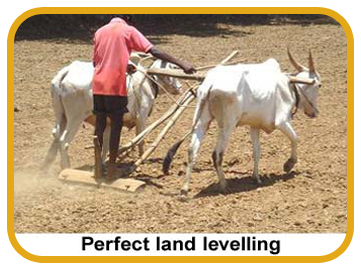 |
| |
Varieites |
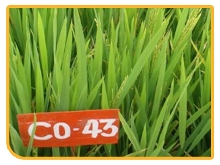
|
All the varieties recommended for transplanting can do well under direct wet seeded conditions also. However, the following varieties are more suited.
| Varieties |
Duration (Days) |
Time of Sowing |
| Ponmani |
160 to 165 |
1st to 30th August |
| Co 43, IR20, ADT 38 ADT 39, Ponni, Improved White Ponni |
125 to135 |
1st to 30th September |
| ADT 36, ADT 37 |
105 to 110 |
1st to 10th October |
|
|
| Manures and Basal Fertilizer application |
|
Application of organic manures
- Apply 12.5 t of FYM or compost or green leaf manure @ 6.25 t/ha.
- If green manure is raised @ 20 kg /ha in situ, incorporate it to a depth of 15 cm using a green manure trampler or tractor.
Stubble incorporation
- Apply 22 kg urea / ha at the time of first puddling while incorporating the stubbles of previous crop to compensate immobilization of N by the stubbles.
- This may be done atleast 10 days prior to planting of subsequent crop.
Biofertilizer application
Mix 10 packets (2000 g)/ha of Azospirillum and 10 packets (2000g/ha)of Phosphobacteria or 20 packets (4000g/ha) of Azophos inoculants with 25 kg FYM and 25 kg of soil and broadcast the mixture uniformly in the main field before transplanting and Pseudomonas fluorescens (Pf 1) at 2.5 kg/ha mixed with 50 kg FYM and 25 kg of soil and broadcast the mixture uniformly before transplanting.
Application of inorganic fertilizers
- Apply fertilizer nutrients as per soil test recommendations.
- Blanket recommendation : 50:25:25 kg N:P2O5:K2O/ha.
- Apply 25% of recommended N and K fertilizers before transplanting.
- Recommended Phosphorus fertilizer may be applied as basal and incorporated.
- Apply 25 kg of zinc sulphate with 50kg sand just before transplanting.
|
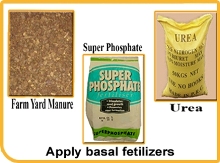
 |
| |
Sowing |
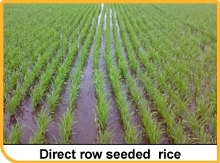
|
- Follow a seed rate of 60 kg / ha
- Pre-germinate the seeds
- Sow the sprouted seeds by drum seeder or broadcast uniformly with thin film of water.
- Dual cropping of rice-green manure is economic for nutrient budget and efficient for grain production. For this method use ‘TNAU Rice-Green manure seeder’.
After cultivation:
- Thinning and gap filling should be done 14 - 21 days after sowing, taking advantage of the immediate rain.
- If dual cropped with green manure, incorporate the green manure when grown to 40cm height or at 30 days after sowing, whichever is earlier, using Cono-weeder.
- Green manure incorporated fields may be operated again with rotary weeder a week later in order to aerate the soil and to exploit organic acids formed if any.
|
|
| Water Management |
|
- During first one week just wet the soil by thin film of water.
- Depth of irrigation may be increased to 2.5cm progressively along the crop age.
- Provide adequate drainage facilities to drain excess water or strictly follow irrigation schedule of one day after disappearance of ponded water. Last irrigation may be 15 days ahead of harvest.
|
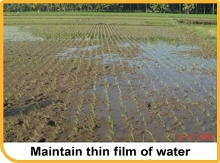 |
| |
Top |
| Dry System |
|
In this system the fields are ploughed and harrowed in summer for achieving the required tilth. The seed is sown directly with the onset of the monsoon showers, either by broadcasting, dibbling behind the country plough or by drilling in lines. Line-sowing is preferable, as it ensures an adequate stand establishment and facilitates easy weeding and interculture.
|
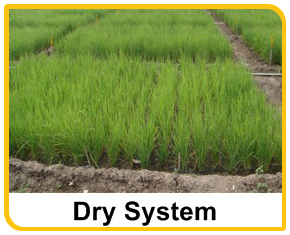 |
| Dry Seeded Rainfed un-puddled Low Land |
| Field Preparation |
- Whenever possible give one or two summer ploughings to minimize weed growth
- Dry plough to get fine tilth taking advantage of rains and soil moisture availability.
- Perfect land leveling for efficient weed and water management.
- Ensure deep tillage and fine tilth at the time of final land preparation for sowing.
- Provide shallow trenches (15 cm width) at an interval of 3m all along the field to facilitate draining excess water at the early growth stage.
|
 |
| |
Varieites |
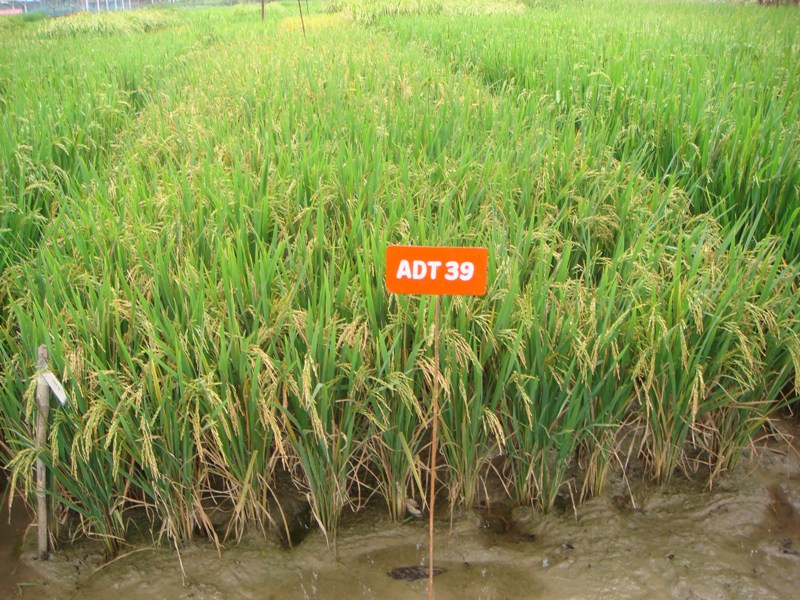
|
Short duration varieties are more suitable
|
|
| Manures and Basal fertilizer application |
|
- Blanket recommendation : 50:25:25 kg N:P2O5:K2O /ha
- Apply a basal dose of 750 kg of FYM enriched with fertilizer phosphorus (P at 25 kg/ha)
- Basal application of FeSO4 at 50 kg/ha is desirable for iron deficient soil.
|

|
| |
Seed Rate and Sowing |
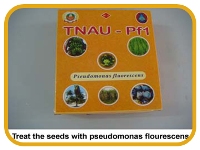

|
- Seed rate: 75kg/ha dry seed for any recommended variety.
- Seed hardening with 1% KCl for 16 hours (seed and KCl solution 1:1) and shade dried to bring to storable moisture. This will enable the crop to withstand early moisture stress.
- On the day of sowing, treat the hardened seeds first with Pseudomonas fluorescens 10g/kg of seed and then with Azophos 2000g or Azospirillum and Phosphobacteria @ 600g each per ha seed, whichever is available.
Broadcasting: The seeds are sown by broadcasting when the moisture is at the marginal level and the surface soil is compacted by a light roller for compacting the seeds with moist soil.
Line sowing: Sowing /dibbling behind the country plough. Line sowing is better than broadcasting. Using seed drill to ensure optimum population, reduce the seed rate and for early intercultivation.
- Drill sow with 20 cm inter row spacing using seed drill.
- The seeds can also be sown behind the country plough
- Depth of sowing should be 3 - 5 cm and the top soil can be made compact with leveling board.
- Pre-monsoon sowing is advocated for uniform germination.
|
| After Cultivation |
|
- Azospirillum inoculants 10 packets (2000g/ha) and Phosphobacteria 10 packets (2000g/ha) or 20 packets (4000g/ha) of Azophos mixed with 25 kg of FYM may be broadcasted uniformly over the field just after the receipt soaking rain / moisture.
- Thinning and gap filling should be done 14 - 21days after sowing, taking advantage of the immediate rain
- Spray Cycocel 1000 ppm (1 ml of commercial product in one lit. of water) under water deficit situations to mitigate ill-effects.
- Foliar spray of Kaolin 3% (30 ml in 1 lit. of water) or KCl 1% (10 ml in 1 lit. of water) to overcome moisture stress at different physiological stages of rice.
|
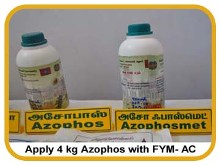
|
| |
Weed Management |

|
- First weeding can be done between 15 and 21 days after germination.
- Second weeding may be done 30 - 45 days after first weeding.
- Apply pendimethalin 1.0 kg/ha on 5 days after sowing or Pretilachlor + safener (Sofit) 0.45kg/ha on the day of receipt of soaking rain followed by one hand weeding on 30 to 35 days after sowing.
|
| |
Top
|
|
| Rainfed Upland Rice |
| Field Preparation |
- The success of the direct seeded rice depends entirely on the monsoon rains,besides proper stand of crop.
- If sowing is done in a properly prepared land, proper stand of crop can be achieved.
- A field with fine tilth facilitates the seed to come in contact with the soil moisture after drilling and enables the seed to germinate quickly and uniformly.
- Thus, an ideal preparation of the land will help to achieve a uniform stand, facilitate weeding and fertilizer practices.
|
 |
| |
Varieties |

|
Short duration varieties like PTB 28, PTB 29, PTB 30
|
| Manures and Basal fertilizer application |
|
- In Tamil Nadu, P is applied at 25 kg/ha as enriched FYM at the time of last ploughing.N at 50 kg/ha and K at 25 kg/ha should be applied in two splits viz.20 to 25 DAS and the second at 40 to 45 DAS.
- In kerala, For modan cultivation (upland crop) Apply the full dose of P2O5 (20 kg/ha) at the time of land preparation as basal dressing and apply nitrogen (40 kg/ha) in three equal split doses, first as basal dressing, second at tillering stage (three weeks after seeding) and the third at panicle initiation stage (about thirty days before flowering).
- Apply K2O (30 kg/ha) either in a single dose as basal or in two split doses half basal and half at the panicle initiation stage.
|
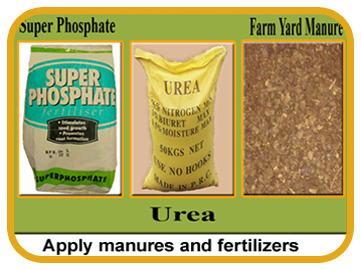 |
| |
Seed Rate and Sowing |
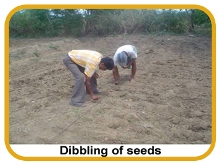
|
Seed rate – 80-100 kg/ha
Broadcasting: The seeds are sown by broadcasting when the moisture is at the marginal level and the surface soil is compacted by a light roller for compacting the seeds with moist soil.
Line sowing: Sowing /dibbling behind the country plough. Line sowing is better than broadcasting. Using seed drill to ensure optimum population, reduce the seed rate and for early intercultivation.
|
|
| Weed Management |
|
- Under upland condition, weeds reduce the yield to the extent of 50 %.
- First weeding should be done at 15 to 20 DAS and second weeding may be done on 45 DAS.
- Under unfavourable rainfall conditions, application of Thiobencarb 2.5l/ha or Pendimethalin 3.0 l/ha 8 DAS as sand mix if adequate moisture is available followed by one hand weeding on 30 to 35 DAS.
|
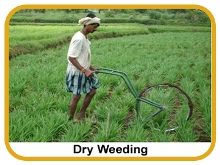 |
| |
Top |
| |
Semidry System |
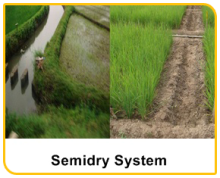 |
In this system seeds are sown in ploughed dry soil with monsoon rains. Whenever water is available after onset of monsoon, it is treated as wet paddy. In command area, anticipating the release of water, rice crop can be raised under semi dry condition up to a maximum of 45 days. Then the crop in converted in the wet condition on receipt of water.
|
Dry seeded rice in unpuddled lowland |
| Area and Field Preparation |
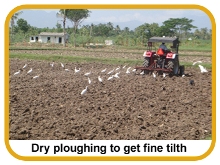 |
Area - Chengleput, Ramnad, Kanyakumari and Pudukottai district in TamilNadu.
Field preparation
- Dry plough to get fine tilth taking advantage of rains and soil moisture availability.
- Apply gypsum at 1 t/ha basally wherever soil crusting and soil hardening problem exist.Perfect land leveling for efficient weed and water management.
- Provide shallow trenches (15 cm width) at an interval of 3m all along the field to facilitate draining excess water at the early growth stage.
|
| Manures and Basal fertilizer application |
|
Blanket recommendation: 75:25:37.5 kg N:P2O5:K2O/ha
- Apply a basal dose of 750 kg of FYM enriched with fertilizer phosphorus (P at 25 kg/ha).
- Apply N and K in three splits at 20-25, 40-45 and 60-65 days after germination. Each split may follow 25 kg N and 12.5 kg K20.
- Basal application of ZnSO4 at 25kg/ha and FeSO4 at 50 kg/ha is desirable wherever Zinc and iron deficiency were noted.
|
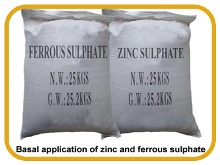 |
| |
Seed Rate and Sowing |

|
- Seed rate: 75kg/ha dry seed for any recommended variety.
- Seed hardening with 1% KCl for 16 hours (seed and KCl solution 1:1) and shade dried to bring to storable moisture. This will enable the crop to withstand early moisture stress.
- On the day of sowing, treat the hardened seeds first with Pseudomonas fluorescens 10g/kg of seed and then with Azophos 2000g or Azospirillum and Phosphobacteria @ 600g each per ha seed, whichever is available.
- Drill sow with 20 cm inter row spacing using seed drill.
- The seeds can also be sown behind the country plough
- Depth of sowing should be 3 - 5 cm and the top soil can be made compact with leveling board.
- Pre-monsoon sowing is advocated for uniform germination.
- Pre-monsoon sowing with medium duration variety is an advantage for higher grain yield and as well to manage the heavy rainy season.
|
| Weed Management |
|
- First weeding should be done between 15 and 21 days after germination.
- Second weeding may be done 30 - 45 days after first weeding.
- Apply pendimethalin 1.0kg/ha on 5 days after sowing or Pretilachlor + safener (Sofit) 0.45kg/ha on the day of receipt of soaking rain followed by one hand weeding on 30 to 35 days after sowing.
|
 |
| |
Water Management |
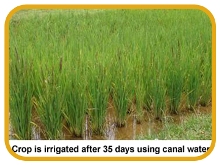
|
- The crop is irrigated from 30-35 days onwards, utilizing water impounded in the tanks or canal.
- Irrigation may be to a depth of 2.5-5.0cm only. Follow the schedule of one day after disappearance of ponded water in order to save water and to bring additional this type of rice cultivation.
|
| |
Top |
| Hybrid seed production |
 |
The success and sustenance of hybrid rice technology depends on the efficient and economic hybrid seed production, so as to provide good quality seed at reasonable price to the farmers. Hybrid seed production, in self pollinated crop like rice, is quite tedious. Therefore, extensive trials were conducted to standardize the seed production package. Various requirements for successful seed production such as ideal locations/seasons, seed rate, row ratio, GA3, supplementary pollination techniques etc., have been worked out and a seed production package has been developed. The details of the package are as under. |
| Optimum package for hybrid rice seed production and CMS multiplication |
| Activity |
Particulars |
| Seed rate |
: |
Seed parent 15 kg/ha
Pollen parent 5 kg/ha |
| Nursery |
: |
Sparse seeding to ensure multitillered (4-5) seedlings in 25 days |
| Row ratio |
: |
2B:10A, for CMS multiplication
2R:12A, for hybrid seed production |
| Number of seedlings/hill |
: |
2 seedlings/hill for seed parent and
3 seedlings/hill for pollen parent |
| Spacing |
: |
B/R to B/R - 30 cm
B/R to A - 20 cm
A to A - 15 cm |
| GA3 application |
: |
45 g/ha at 5% heading in two split doses on consecutive days |
| Supplementary pollination |
: |
Twice a day at peak anthesis during flowering phase |
| Roguing |
: |
Twice during vegetative phase based on morphological characters and twice during and after flowering based on floral characters sterility etc. |
| Seed yield (t/ha) |
: |
1.0-1.5 |
| Land selection: |
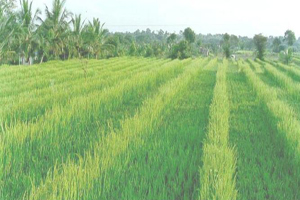 |
The selected land should not have been cultivated with the same variety in the previous season and the land should be free from volunteer plants. The land should have good drainage facilities, sunshine and wind flow. Since cross pollination has to take place through wind, adequate wind flow is required. |
| |
| Sowing Season: |
- Kharif - (May- June sowing)
- Rabi - (December- January sowing)
- December – January sowing is most favourable for getting quality seeds.
|
| |
| Pre Sowing Seed Treatment: |
Dormancy breaking treatment:
Seeds are soaked in KNo3 0.5% for 16 hrs.
Seed hardening treatments:
Paddy seeds are soaked in 1%KCL solution for 10 hours in 1:1 ratio. Then they dried back to the original moisture content then the seed are treated with captan / thiram @ 4g/kg and also with azospirillum / azotobacter @ 3 pockets / acre seeds. |
| |
Nursery:
For a nursery of 40m2, apply 2 kg of DAP and sow male and female seeds at 1 kg / 40 m2 (1 cent) sparsely in separate nurseries. Because of DAP application and sparse sowing, vigorous seedlings can be obtained within 20 days. |
| |
| Row Ratio : |
| The optimum age of seedlings for transplanting in the main field is 18-21 days. Use 2-3 seedlings per hill for transplanting of male seedlings. One well developed seedling with 2-3 tillers is preferred for planting of female line. The female and male seedlings are transplanted at 8:2 ratio simultaneously in the main field. Row ratio and spacing of A and R lines in the main field |
Female and male seedlings have to be planted by adopting the following spacing.
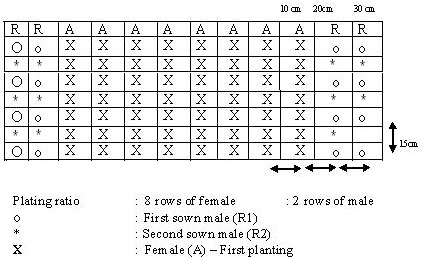 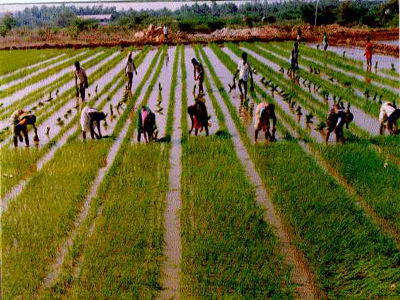
|
| |
Spacing :
- Female x Female - 10×15 cm
- Female x Male - 20 cm
- Male x Male - 30 × 15cm
|
| |
Roguing :
In the male and female rows, roguing is essential from the initial stage.Rogueing should be done based on the plant height, flowering behaviour, flower colour and pollen colour. In the female rows, rogue out all the pollen shedders. Normally, in the female parent 40-50 per cent of seed set is possible. If there is a plant with more than 75 per cent seed set, that may be a pollen shedder or off-type, which has to be immediately rogued out. |
| |
Supplementary pollination :
Rope pulling or rod driving for 10 days from 20% flowering is done at 10-12 noon and 3-4 p.m. for one week to facilitate pollen dispersal and effective pollination. |
| |
Application of Gibberellin :
GA3 is one of the essential requirements for hybrid seed production and it is a costly input. Therefore, efforts are being made to find some alternate chemicals or substitutes to economize GA3 use. Initial results have indicated that GA3 requirement can be reduced by using some chemicals such as ZnSO4, urea and boric acid in combination with lower doses of GA3.Such studies will help to reduce the cost of seed production thus helping the farmers to get the hybrid seed at reasonable cost which is now being sold @ Rs. 90-100/kg. |
| |
Advantages of GA3 application :
- Enhances panicle and stigma exertion, Adjusts plant height of seed and pollen parents, Speed up the growth of late tillers and increases the effective tillers.
- Sets uniform panicle layer, Flag leaf angle is increased, Increases 1000 grain weight, Reduced unfilled grains, Remarkably enhances seed setting and seed yield.
|
| |
Synchronisation of flowering :
The optimum standard of synchronization flowering is that the female parent should be 2 days earlier than the male parent.If the differences in the predicted flowering date is more than 3 days between the parental lines, then adjustment is needed.
- If the flowering is to be delayed in female line, spray 2% urea (2g in 100ml of water) solution with knapsack sprayer on male parent to induce vegetative growth.
- If the flowering is to be hastened, apply 1% Di Ammonium Phosphate solution to induce flowering.
- If the male male parent is late in flowering, it can be advanced by increasing the water level in the field.
- Draining the water will delay the flowering.
|
| |
Harvesting :
At fully mature stage, harvest the male parent first and remove from the field and then harvest the hybrid seed in female parent. |
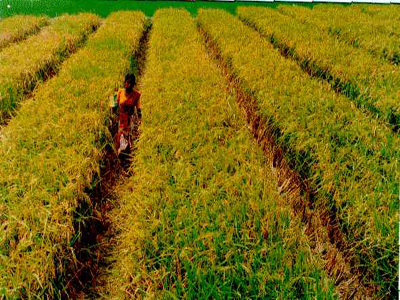 |
| |
Threshing and drying :
Hybrid seeds are very delicate in nature and so are highly vulnerable to mechanical injury. Manual threshing when the seed moisture is between 15 and 18 per cent will minimize mechanical injury. Hybrid seeds can be threshed using mechanical thresher with careful adjustments to reduce injury. The seeds can be dried to 12 per cent moisture for safe storage. |
| |
Seed yield :
Seed producers can obtain seed yields of about 1.0 to 1.5 t/ha by adopting this package. There is a need to refine the present technology so as to enhance the seed yields up to 2.0 to 2.5 t/ha so that the seed cost can be reduced. |
| Seed production in varieties |
Land requirement :
The selected land should not have been cultivated with same variety in the previous season and the land should be free from volunteer plants. |
| |
Isolation distance :
Rice is mainly a self pollinated crop. For pure seed production, the seed fields must be isolated at least by 3 meters from rice fields of other varieties. |
 |
| |
Season :
| Varieties |
Suitable Season |
| Short duration (105-110 days) |
November-December |
| Mediumduration (110-125 days) |
November |
| Long duration(125-145 days) |
August |
|
| |
Seed rate:
- Short duration - 60 kg/ha
- Medium duration - 40 kg/ha
- Long duration - 30 kg/ha
|
| |
| Upgradation of seed quality using salt solution : |
| The density of stored seed diminishes during storage period, place, environment and pest and diseases. Aged seeds like used battery cells will loose vigour in due course of time. Using salt solution, good quality, denser and vigorous seeds can be separated. |
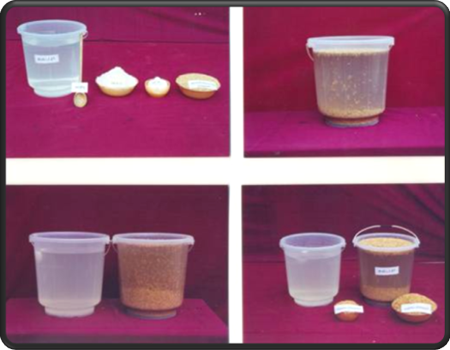 |
| |
Seed treatment :
Seeds treated with a fungicide like bavistin or captan @ 2g/kg and kept overnight before sowing in the nursery. |
| |
Nursery :
Good management of the nursery will result in vigorous seedlings and also in controlling the occurrence of offtypes in the seed crop. The land on which rice nursery or rice crop was not grown in the previous season should be selected to prevent offtypes. If the previous crop was rice, then the nursery plot should be flooded with water to trigger germination of buried seeds and such germinated seedlings can be destroyed by ploughing the field after one week. Fertile soil with adequate drainage is essential for good nursery. |
| |
| Nursery sowing: |
For sowing 50 kg of seeds required for one ha, a nursery area of 800 m2 is required. The soil of nursery should be well pulverized by 2-4 ploughings and during last ploughing one tonne of farm yard manure should be applied. Nursery beds of 40m2 area are prepared.
Seeds are pre-germinated before sowing. For pregermination, the seeds are soaked in water for 12 hours and soaked seeds are loosely packed in gunny bag and then placed in darkness for 24 hours for sprouting. During the pregermination process, radicles would have protruded out of the seeds.
The water used for soaking should be pure. Already used water should not be used for soaking to avoid the spread of diseases through seeds. |

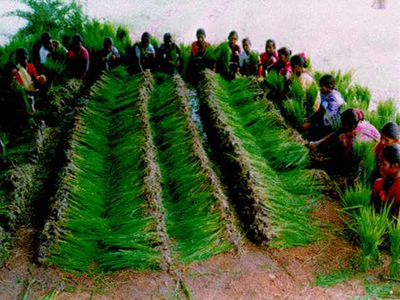
|
| |
Age of seedlings:
Age of seedlings plays an important role in the growth of crop. A too young or too old seedling leads to reduction of yield. Based on the duration of the varieties, the age of seedlings suitable for transplantation varies.
| Varieties |
Age of seedlings |
| Short duration |
13-22 days |
| Medium duration |
25-30 days |
| Long duration |
35-40 days |
|
| |
Preparation of main field for transplanting :
Spread 25 tonnes of FYM on the field which selected for seed production. Then the field is irrigated and the land is ploughed 2 or 3 times and puddled. Before last puddling, urea, super phosphate and Murate of Potast are applied basally as per the following table:
Basal application of fertilizers in different varieties
| Varieties |
Urea (Kg) |
Super phosphate (Kg) |
MOP (Kg) |
| Short duration |
50 |
125 |
20 |
| Medium duration |
50 |
125 |
30 |
| Long duration |
50 |
125 |
40 |
For zinc deficient fields, basal application of zinc sulphate @ 30 kg/ha is recommended. After last ploughing, the fields are well levelled. |
| |
Spacing for different rice varieties :
| Varieties |
Spacing (cm) |
| Short duration |
20×10 |
| Medium duration |
20×15 |
| Long duration |
20×20 |
In the main field, after each 8 feet, a gap of one foot is to be left which is required for easy rouging. This is called rouging space. |
| |
Water management :
Water level upto a height of 2 cm should be maintained for a period of one week after transplantation. On 30th day, water should be drained off completely for one or two days. This enables aeration in soil and increases root growth. During tillering stage a water level of 5 cm should be maintained. During booting, flowering and milking stages, water stress should be avoided. During maturity stage, 15 days before harvest, water is drained off completely from the field. |
| |
Weed Control:
Within three days after transplantation, herbicide butachlor @ 2.5 lit ha-1 mixed with 20 kg sand should be applied to the field. Use of rotary weeder from 15 DAT at 10 days interval. After 30-35 days, a hand weeding is essential. |
| |
Fertilizer application:
After first weeding and during flowering stage, urea is applied and during milky stage, muriate of potash is applied. The dosage of fertilizer depends upon the duration of the crop. |
| |
Rouging:
Normally in rice fields, non-uniform height and differences in flowering among plant population is observed. The crop of the same variety cannot show such variations and so this shows the contamination of the seed field with some other varieties which affect the genetic purity of the seed crop. Also, certain weeds grow along with the crop seeds. Similarly some field fungi cause seed infection in the field itself.
The off-type plants, weeds and diseased plants should be rogued out at appropriate stage preferably before flowering. By this, genetic purity of the seeds can be maintained.
| Stage of crop |
Rogues to be removed |
| Before flowering |
Very tall or short plants, early flowering plants. |
| Flowering stage |
Late flowering plants, chaffy grains |
| Pre-harvest stage |
Awned grains |
| Harvest stage |
Based on seed size, shape and colour |
|
| |
Foliar application:
Spraying 2 per cent DAP results in higher seed yield with good quality. Depending upon the duration of the crop, the stage for DAP spray also varies. |
| |
Appropriate stage for harvesting:
Harvesting of seed crop at correct stage is essential. Otherwise, seed yield will be greatly reduced. If the seeds are harvested at premature stage, the seeds get shrunk (during drying), thereby reducing the germination capacity. Delayed harvest results in discoloration of seeds besides inviting pest and disease incidence.During maturity stage, 90 per cent of seeds would have acquired straw colour and seed moisture content will be 17-20 per cent. |
| |
Threshing without mechanical injuries:
The seed moisture content should be 15 to 18 per cent during threshing. If the seed moisture content is more or less than this level, the chances of mechanical injuries are more. These invisible injuries will reduce seed viability and increase disease incidence on the seeds. |
| |
Seed drying:
Threshed seeds should be dried immediately in a systematic manner. Otherwise deterioration due to high respiration rate may occur. If the seeds are heaped without drying, temperature of the seeds may increase. Optimum time for drying the seeds under sun is 8.00 am to 12.00 noon and 3.00p.m. to 5.00p.m. Drying of seeds during 12.00 noon to 3.00p.m. should be avoided as the incidence of UV rays from the sun is more besides temperature being high during this time.
Continuous drying of seeds from morning to evening under sun should be avoided. The seeds should be spread evenly every day after sun drying allowing free aeration otherwise, heating will occur resulting in lowering of seed quality. |
|
















































